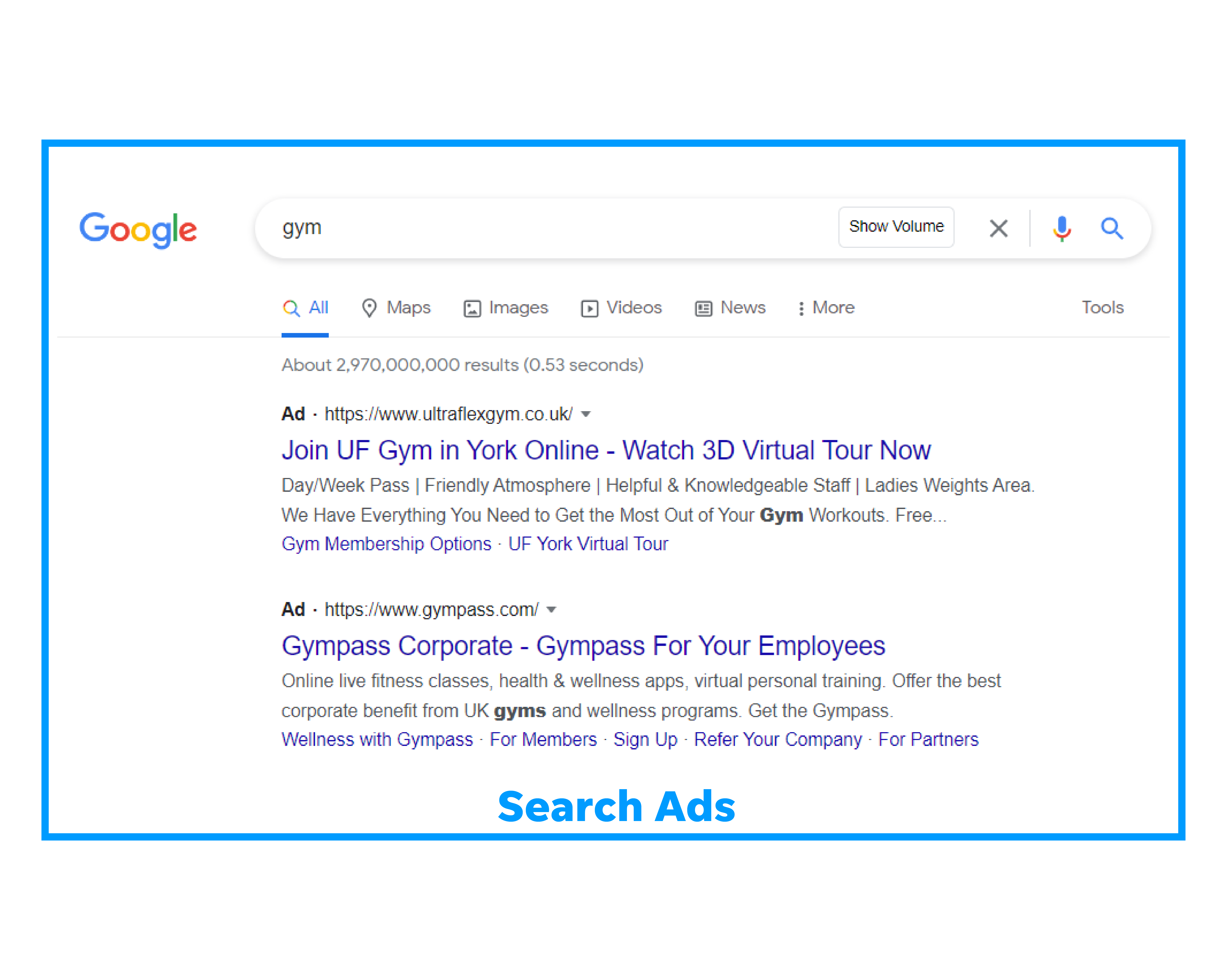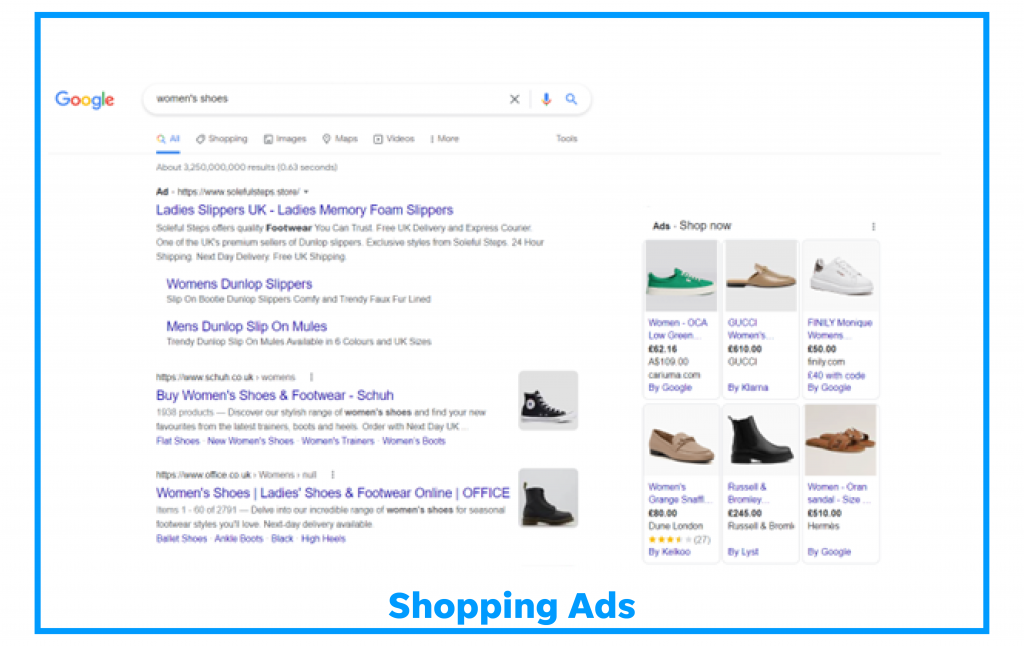You have probably heard the terms SEM and PPC used interchangeably. We often get asked if search engine marketing (SEM) and pay-per-click (PPC) are the same. Despite their similarities, they are slightly different.
SEM and PPC are paid initiatives through search and other platforms.
SEO is the organic effort that goes into marketing through search engines.
What is SEM?
The term ‘SEM’ refers to search engine marketing, which is the blanket term referring to all marketing methods used to increase the visibility of a website via search engines (Google, Bing, etc.). There are many marketing techniques that fall under its umbrella, including Search Engine Optimization (SEO) and PPC.
SEM covers more than just paid marketing, it is both paid and unpaid, PPC, or organic traffic. Basically, any type of marketing carried out on a search engine is considered SEM.
Because SEM is so broad there are a variety of ad formats to choose from. Ads can be text-based or more visual, like product listing advertisements (shopping ads), which give consumers information about the product at-a-glance, such as price and reviews.
Example of text ad and shopping ad:


How does SEM work?
Because search engines are predominately text-based, advertisers bid on keywords that search engine users might enter when looking for certain products or services. This gives the advertiser the opportunity to display their ads alongside results for those specific search queries.
Pros:
- Delivers instant and measurable results.
- Variety of detailed targeting options.
- Has the potential to produce an impressive return on investment (ROI).
- Conversion tracking and detailed data analytics so you can monitor ad performance in real time and gather information about the users engaging with them.
Cons:
- Due to the nature of search engines, users are exposed to a lot of options for the same product, so you can be easily compared to your competition.
- It can get expensive but the more ads the more website traffic you are likely to generate.
- Predominately text-based ad formats.
- Can decrease your credibility as people tend to prefer organic search results.
Best SEM tools:
- SEMrush: SEMRush allows you to conduct extensive keyword research, keyword rank tracking, site audits, traffic analysis, and more.
- Keywords everywhere – A free plug-in for Chrome & Firefox that shows search volume, search difficulty, suggested keywords, and competition on multiple websites.
- Moz Search Bar– A free Chrome Extension that makes it easy to get link metrics and do all your SEO on the go.
- Google Trends – a website by Google that analyses the popularity of search queries in Google Search across various regions and languages.
- Google Ads Keyword Planner – a tool by Google that helps you find keywords that are most relevant for you business and choose the right keywords for your ads.
- WordStream – Use their free keyword toolto find keywords for your PPC campaigns, or their free Google Ads performance grader to get a true read on your ads performance.
What is PPC?
PPC (pay-per-click) is an advertising model that uses sponsored listings and adverts to drive traffic to a website (making it an SEM technique). This form of advertising is most closely associated with Google, however, unlike SEM, PPC works with search engines and other channels such as video ads on YouTube and visual ads on social media.
Learn how to successfully run a paid search campaign.
Types of PPC
- Paid search marketing: the most common type of PPC advertising and the most common marketing technique which falls under the SEM. This type of PPC is conducted solely through search engine platforms.
- Social media advertising: PPC ads on social media are very effective because it doesn’t require the customer to conduct a search to see your ad.
- Display marketing: these are the banners, images, or text ads within a website that are typically based on your previous searches.
- Affiliate marketing: A lot of brands use PPC marketing for affiliates, allowing them to earn money when users click on their individual profile or personal page.
Examples of PPC ads

How does PPC work?
Essentially PPC is a business model where marketers pay each time someone clicks on their ad. Similarly to SEM, PPC ads work based on keywords. Advertisers can bid on words or phrases that, when searched, will display their advertisement. With PPC, you don’t pay for the ad on the SERP directly, instead, you pay each time someone clicks on that ad to get to your website.
Pros:
- You can showcase your ads on multiple different sites and networks.
- Since you pay when a user actually reaches your website, PPC is cost-effective. Additionally, there are budgeting options so you can choose to spend as much or as little as you like.
- Delivers almost immediate results especially in comparison to organic SEM.
- PPC lets you access big data. You can track all your results and monitor campaign performance using tools such as Google Analytics.
Cons:
- PPC can be risky. Traffic can be inconsistent, and clicks don’t guarantee sales.
- Maintaining PPC ads is time-consuming. You need to invest time into optimising and improving to get the best results.
- Similar to SEM, PPC ads can decrease your credibility, as some people prefer using organic search results.
- It requires skills to set up effective campaigns. Often businesses will choose to use a specialist agency.
PPC vs SEM: the similarities and differences.
The similarity between PPC marketing and SEM is that they are both paid advertising initiatives that take place on search engines and offer real-time analytics. However, while PPC is the largest and most demanding component of SEM, these two strategies are very different.
The main difference is PPC can be used on social networks, which is something that SEM does not have the capability of doing (it is restricted to marketing activity solely carried out through search engines). Google ads are an example of PPC marketing because they allow ads to be showcased outside of the search engine, using the “Google Display Network.”
SEM is a long-term strategy to bring in organic traffic, whereas PPC is generally a quick and easy way to get your business’s ad to the top of the SERP. Nevertheless, SEM results are usually long-lasting once they are achieved, unlike PPC which produces short-term results that stop as soon as your budget runs out.
Since most users click through organic results more often than paid ads, you won’t gain the same level of visibility and conversions with PPC as you would with effective organic SEM.
Ideally, you should use both SEM and PPC in your online advertising campaign, but you will need a substantial budget for both. You will get instant exposure through PPC ads, but persistent SEM strategies will result in steady traffic over time.
At LOCALiQ we take the time to understand your business, creating the most cost-effective paid advertising campaign for your budget – ensuring your paid ads appear in front of the right people.
Our team of digital marketing specialists provide you with expert marketing support – from PPC campaign management and professional SEO and content marketing services, to paid social, digital display advertising and much more.
Get in touch to find out how to get the best results from your campaigns.






